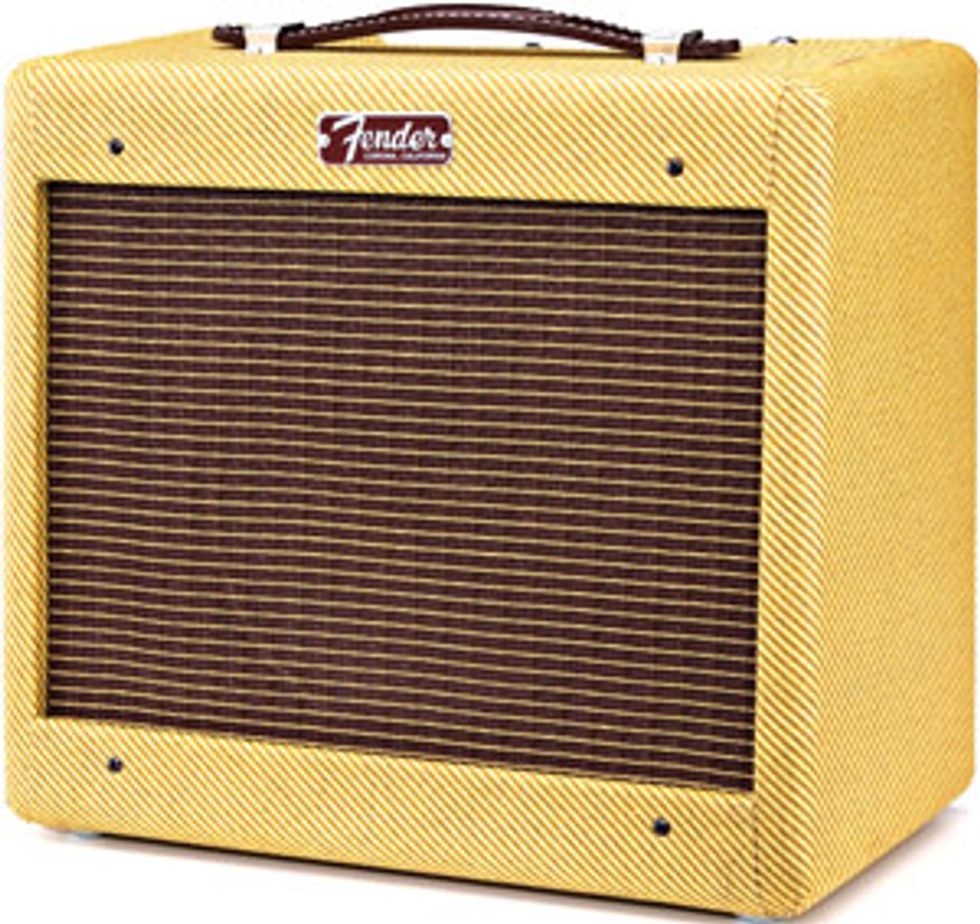  | |
| Download Example 1 Chord Tones - volume ascending | |
| Download Example 2 Single String Tones - volume ascending | |
| All clips were recorded with a '94 40th Anniversary Strat, middle pickup. | |
[thunderous applause]
Actually, the Champ needs no introduction, unless you’ve been on an extended journey to another galaxy, that is. It has been riding the crest of Fender amp popularity for the past 60 years or so, ever since its introduction in the late ’40s as the Champion 600 (6” speaker) and 800 (8” speaker). Since its timely birth from a circuit found on the back pages of an old tube manual, the Champ has been through many changes. The original three-watt circuit became the 5D1 and 5E1 circuits, each with increasing output. The next revision produced our present review subject, the ’57 5F1, sporting a whopping five watts of output. The evolution of the circuit has continued to the present day, with only mildly contentious agreement among tonemongers that the 5F1 is the best sounding Champ of all—thus producing the otherwise unlikely comeback of this 52-year-old contender.
Our review specimen measures approximately 14"w x12"h x7" with a pine cab expertly covered with tweed cloth. It has a thin leather handle and a rear mounted chrome-plated steel chassis with an On/Off switch, a jewel pilot light, a chicken head Volume knob (that goes from 1–12) and two 1/4" input jacks (the number two jack is attenuated to accommodate high-gain outputs). The rear tweed panel has a perforated metal cooling screen over the area of the circuit board and also mounts a three-side ventilated protective metal cage surrounding the rectifier and output tubes. These additions to the old design, along with internal fuses, have been added to make it safety compliant worldwide. The front speaker panel is covered with vintage-style grille cloth very similar to the original. There is a Fender logo plate above the speaker grille.
If we look under the hood we find three tubes: the preamp tube is a Groove Tubes 12AX7; the power tube is a GT 6V6GT; and the tube rectifier is a Ruby (Chinese) 5Y3. The speaker input jack has mercifully been changed from an RCA phono to a 1/4" TS jack. The tube sockets, all connections to other components and the component mounting eyelet board are all expertly handwired and soldered. There are three internal fuses (new) and one external fuse (original). The power supply transformer is beefy, as is the output transformer—both made by Schumacher, which have been used in Fender amps since the ‘50s. All components are of very good quality and tight tolerance. The speaker deserves special mention, being designed and manufactured for Fender especially for this amp by Ted Weber of Weber VST. It uses an Alnico magnet with no bell cover to allow it to fit into the tight space afforded.
Why all the Fussy Tech Stuff?
What is it about this Champ that spawned a demand for its reissue when Fender already has a few Champ models in its present-day lineup? The 5F1 Champ is a single-ended, Class-A-operating, cathodebiased circuit. Its main change from the preceding 5E1 circuit was the change of the power supply to a capacitative input filter power supply, which added low end and a punchier attack envelope. Later circuits added a negative feedback loop to the output to flatten out the frequency response. This would be a characteristic of the blackface circuits with their increased high end and scooped mids, while the lack of negative feed back would be a characteristic of the “brown sound” of the tweed generation represented by this amp.
Class-A operation essentially means that the power tube is running at full power all the time, as compared to class-AB/pushpull operation, which requires at least a pair of power tubes, and each side “rests” in either the positive or negative excursion of the speaker. Class-A operation requires a heavier power supply and output transformer designs, and due to its high operating temperatures will cause tube and component failure in fewer hours of operation. Most modern tube amps use class AB, some use a mix of the two modes and some use pure class A. Class A lends itself nicely to small, low-power amps. Larger, higher-powered class-A amps can be identified by their heavy weight, high price tag, and high heat (often requiring cooling fans).
What makes the Class-A amp desirable for many guitarists is the way the output tube distorts. Class-A output distortion strongly favors the even order distortion overtones, while class AB favors the odd order overtones. Even order distortion is far more pleasing to the ear in most situations and iscommonly described as having a “singing” quality. Hit a few harmonics while playing this amp and you can hear the bloom of the even order. This Champ combines the best features of the tweed generation in a class-A package that has made it one of the most recorded amps in history.
Going Tone to Tone with the Champ
Plug in, turn on, and dial up; that’s all there is to it. Tweak the Volume until you have the amount of distortion you want. The tone is a given. I started with a clean tone at a Volume of about 3 and proceeded one level at a time until I hit 12. Between 4 and 5 a nice blues crunch emerged. At about 8 we hit fifth gear, and after that the fat lady began to sing and compress but was never able to squash the tone. I went through humbuckers and single coils of several species and always found a sound I liked. The volume was beyond what I would expect from five watts. I pulled out my ’70s SF Champ and went head to head and tone to tone: the ’57 scored a first round knockout. I then hooked the ’57’s speaker up to the SF and redeemed the younger contender greatly. The special design speaker is a major part of the ’57 reissue sound; it’s punchy and sweet. We then went out on the town to a special private after-hours blues jam at a sound studio on the University campus with bass, drums and another guitarist playing through a Deluxe Reverb reissue. We weren’t playing loud and the space was pretty dead acoustically, and the ’57 on 8 held its own. I then did some recording and re-amping and reminded myself why every studio needs a Champ. If you want a big recorded sound use a small, toneful amp. It is also nice to have a reference amp for tone comparison—this is it.
The Whole Vs. the Sum of Its Parts
One obvious criticism, and one I have seen several times on tonehead forums, is that the total value of parts in this amp is much less than the price. It’s a reasonable opinion and one to consider if all you’re looking for is a small amp that sounds good. On the other hand, this amp is an icon in the saga of rock and roll, it has a superb proprietary speaker with tone to match, it is part of a series of historic ’57 Fender reissues that has collectors drooling and is much more likely to hold or increase its value than any other amp in its class. So “you pays your money and you takes your choice.”
Buy if...
you want a superb sounding and collectible amp for recording, practice and small gigs.
Skip if...
you have no use for a small amp, or you already have one you’re happy with.
Rating...
Street $999 - Fender - fender.com |






![Rig Rundown: Russian Circles’ Mike Sullivan [2025]](https://www.premierguitar.com/media-library/youtube.jpg?id=62303631&width=1245&height=700&quality=70&coordinates=0%2C0%2C0%2C0)

















